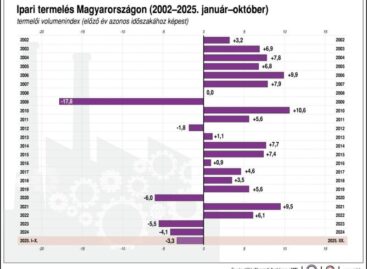Több mint 100 ezres létszámnövekedés az elsődleges munkaerőpiacon
In February-April 2017, the number of people employed in the private sector increased by 105 thousand year-on-year, the latest data show. Compared to the corresponding period of 2010, the number of jobs rose by 685 thousand, the bulk of which was registered in the private sector (475 thousand). The unemployment rate continues to stay at a low level of 4.6 percent, as a result of a 58-month downward trend.
Since the current Government came to office in 2010, the employment rate has improved from 54.6 percent to 67.3 percent, an increase of 12.7 percentage points. In the observed period, the unemployment rate has fallen from 11.5 percent to 4.6 percent, a decrease of 6.9 percentage points, and thus this indicator has hit the lowest level since the regime change. While the youth unemployment rate used to be close to 30 percent, it has by now declined to 10.2 percent whereas the respective employment rate has edged close to 30 percent.
The number of jobless people fell by 56 thousand over the past one year, to 209 thousand. Thanks to the six-year wage agreement, which stipulates minimum wage and guaranteed minimum wage hikes as well as payroll tax reductions, the Ministry for National Economy is expecting favourable labour market trends to continue and economic growth to accelerate. Rising household consumption, the announced corporate development projects, the housing boom driven by Government measures and the acceleration of the disbursement of EU funds are all pointing to further employment growth.
(Ministry for National Economy)
Kapcsolódó cikkeink
Enyhülő inflációs nyomással és csökkenő közterhekkel számolnak a nagyvállalatok
🎧 Hallgasd a cikket: Lejátszás Szünet Folytatás Leállítás Nyelv: Auto…
Tovább olvasom >Másfél éves csúcson zárta 2025-öt a GKI konjunktúra indexe
🎧 Hallgasd a cikket: Lejátszás Szünet Folytatás Leállítás Nyelv: Auto…
Tovább olvasom >KSH: októberben az előző év azonos időszakához mérten 2,7 százalékkal mérséklődött, az előző hónaphoz képest 0,5 százalékkal bővült az ipari termelés
🎧 Hallgasd a cikket: Lejátszás Szünet Folytatás Leállítás Nyelv: Auto…
Tovább olvasom >További cikkeink
Hiába feleződött a kakaó ára, a csokoládé nem lesz olcsóbb
🎧 Hallgasd a cikket: Lejátszás Szünet Folytatás Leállítás Nyelv: Auto…
Tovább olvasom >A Temu letarolja a hazai webshopokat – a karácsony sem hoz változást
🎧 Hallgasd a cikket: Lejátszás Szünet Folytatás Leállítás Nyelv: Auto…
Tovább olvasom >Zöldhitelezés: lendületben a fenntartható finanszírozás
🎧 Hallgasd a cikket: Lejátszás Szünet Folytatás Leállítás Nyelv: Auto…
Tovább olvasom >






